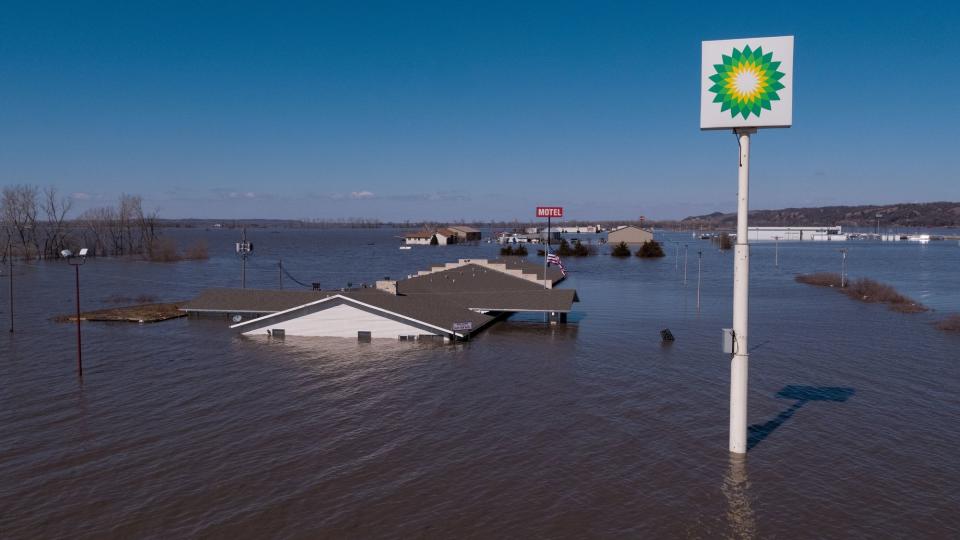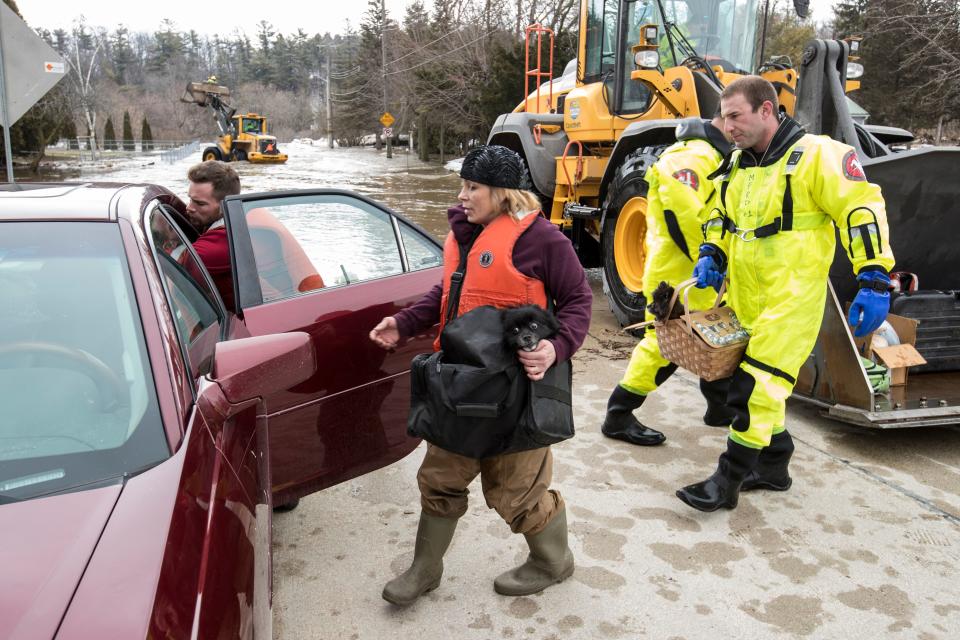'I lost my Dad's bible.' Wrenching stories from Midwest floods, which have cost at least $3 billion
Flooding that has overwhelmed levees and swamped a wide swath of the Midwest since last week's bomb cyclone storm is creating a "slow-moving natural disaster" with damages that total at least $3 billion.
Iowa Gov. Kim Reynolds said Friday the damage cost in her state was an estimated $1.6 billion, so far. Earlier this week, Nebraska's damage total was reported to be over $1.4 billion.
Damage costs from other flooded states, such as Missouri, Kansas, South Dakota, Minnesota and Illinois, had not yet been tabulated.
At least three people have been killed because of the flooding.
Iowa Gov. Reynolds sent a request Thursday to President Donald Trump seeking an expedited presidential major disaster declaration for 57 counties severely impacted by floods along the Missouri River and across the state, where water has inundated homes and businesses, destroyed crops and forced evacuations.
More than 1,200 homes in Iowa have been destroyed or extensively damaged. “I lost my dad’s Bible,” Ronda Mauseth of Missouri City, Iowa, told reporters, her voice breaking, according to KMTV. She stood in a muddied lawn of her water-soaked home, the receded river just beyond the trees nearby. “You can’t replace that stuff.”
“It just totaled everything, everything is mud…it’s just ruined,” Mauseth said to KMTV.
Nebraska's cleanup is also a mammoth task. Damage to roads, levees and other structures in the state has reached almost $450 million. Crop losses were at $440 million and cattle losses totaled $400 million.
"I don't think there's ever been a disaster this widespread in Nebraska," he said.

While rivers are receding – for now – across parts of Nebraska, Wisconsin and Iowa, water draining downstream is causing the Missouri River to rise across northeastern Kansas and Missouri, AccuWeather said. The river's water levels are forecast to challenge the crest record of 31.63 feet at Atchison, Kansas, by the weekend.
As of late Friday, at least 100 river gauges in the central U.S. were listed at "major" or "moderate" flood stage, the National Weather Service said.
Then there is the Mississippi River to contend with. The river is forecast to reach major flood stage in St. Paul, Minnesota, by the end of March, AccuWeather says.
"It is possible that many parts of the Mississippi River will remain above flood stage ... into the first part of the summer in the slow-moving natural disaster," AccuWeather meteorologist Alex Sosnowski said.

The bomb cyclone hammered more than a dozen states with heavy snow and/or rain along with high winds. Much of the region was already saturated or the ground frozen, meaning the water could not be absorbed. The result: More than a dozen states have dealt with flooding, flood watches and flood warnings.
In Minnesota, 35 of the state's 87 counties are already battling flooding or ice jams, city emergency management officials said.
"Significant winter snowpack, deep frost, increased soil moisture, late thaw, recent precipitation and above normal streamflows are all contributing to a higher risk of flooding throughout Minnesota," the agency warned.
More: The waters are rising, the floods are coming. What can we do?
While Missouri River levels are on a downward trend, they will start to rise again when snow in South Dakota begins to melt, warned David Pearson, a hydrologist with the National Weather Service in Omaha, Nebraska. He expects to see that secondary rise of an additional one to two feet by April 1.
“I think we should be vigilant to that for the next month, possibly more," he said.
In Wisconsin, rivers have been receding since early in the week. But the National Weather Service warned that the reprieve may not last long.
"There is still 10-25 inches of snow across northern WI," the officer tweeted. "This will continue to melt over the next several days, and could cause rivers to start rising as it does."
In Missouri, the town of Craig, 100 miles north of Kansas City, was underwater. A mandatory evacuation was ordered for the 250 residents.
"Really all you can do is get as much out as you can and hope for the best," Missouri resident Trais Lawson said, according to AccuWeather.
"Darkness has settled over town, and all you can hear is the sound of rushing water and the damn railroad signals going off," the town tweeted. "@BNSFRailway no trains coming but plenty of water on the tracks. Sleep tight River Rats tomorrow is a new day."
Contributing: Kim Norvell, Kevin Hardy, Des Moines Register; The Associated Press
This article originally appeared on USA TODAY: 'I lost my Dad's bible.' Wrenching stories from Midwest floods, which have cost at least $3 billion

